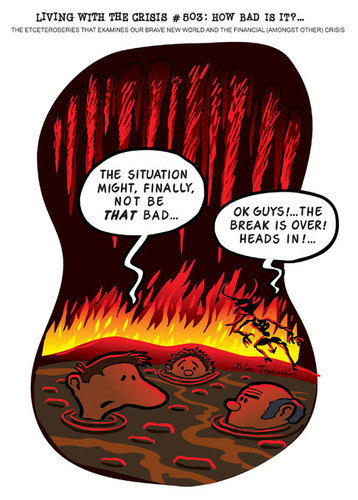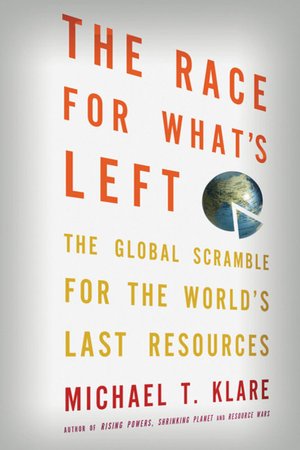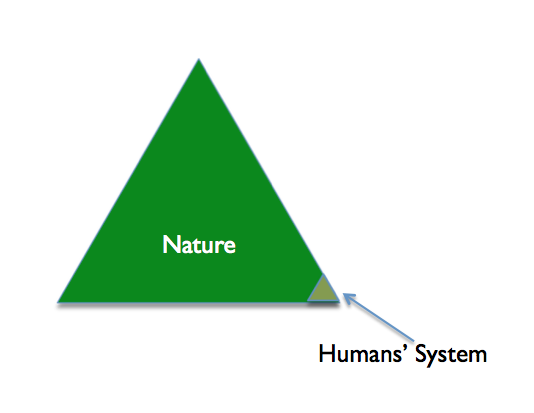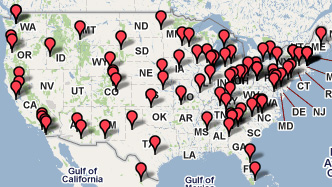Progstone | Some thoughts on the evidence recently posted that appalling conspiracies are currently in play, including powerful circumstantial evidence that (elements of) the current US administration at least colluded in the 9/11 atrocity, and are currently planning Mad Max megadeath horror.
I don't deny that these things are happening. They've always been happening. Thomas Jefferson said, "When men of the same profession gather together, they do so to conspire against the general public." After all, we have the open statement from before the 2000 election by the so-called American Century group of which Dubya & Co are members, that a "major incident" would be very beneficial for their agenda. What I do argue is that these things do not require us to suppose that persons of special knowledge or abilities are involved. It's just what normal sub-human consciousness does, given the opportunity. That's frightening enough on it's own (Gurdjieff wrote of "The Terror of the Situation") - but it's a monster we have already met. The goings on in any firm or local council writ large. There are no worse monsters. I've certainly seen nothing in the behaviour of Dubya, Blair, etc. indicating that any more than normal scheming, reality denying self-aggrandizers are involved, or that their objectives are any more than power crazed, personal material enrichment for their cronies, or the willingness to kill vast numbers in the pursuit of wasting even more resources for a brief while longer. I'm even willing to acknowledge that Dubya is a screwed up mapper (a macker). After all, he is an alcoholic. So despite his manifest cowardice ("I do not have anthrax. I do not have anthrax. I do not have anthrax."), low thinking centre intelligence and ignorance, he might be a quite inventive little toad, and hence all the more dangerous. I've never suggested that an active inductive mind *automatically* ensures goodness or wisdom if the person is emotionally damaged, as often occurs in current social conditions.
Instead I'd like to look at two other situations which at first look like sith might be involved, and demonstrate that we do not need to assume the existence of sith. The first situation has more than one thread to it, so please bear with me. I shall not pretend objectivity, since the whole business still annoys me.
In the late 1970s an artist called John Berger became concerned with what he saw as a growing retreat into delusional meeting room reality, and a consequent loss of all values. He believed that a return to basic physical reality was needed to reacquire our grounding. He moved to a village in rural France, and set forth his views in a novel called "Pig Earth". Berger is an able artist. First a photographer, his TV series "Ways of Seeing" was a landmark in making the arts accessible to a wider audience, and 30 years on his book which accompanied the series is still in print. On page one of the novel he wanted to engage the reader's attention before presenting his thesis, and did this by presenting a graphical visual image of a pair of elderly peasants making a complete mess of attempting to slaughter a cow. Berger can produce a strong visual image even when his medium is prose, and his description of the layers of bone, muscle and blood vessels revealed in the cow's shoulder as the peasants attempt to kill it is certainly strong. But it's just an attention getter. The point - which is all about the base reality revealed in the first page - comes in the rest of the book. "Pig Earth" was first published in New York in 1980, but didn't do well. It was republished in London in 1984 and did much better because it was marketed very aggressively by a close friend, which is why I know all the details of this aspect of the tale. My friend made sure "Pig Earth" was in some chains and every independent and arts bookshop in the land.
At the same time a Turkish embezzler called Asil Nadir was exploiting the growing retreat into self-delusion, enriching himself with a junk bond scam called Polly Peck. Nadir currently resides in the largely unrecognised state of Turkish Cyprus, where he is free from extradition and arrest. As an embezzler, Nadir would benefit from a more relaxed financial regulatory environment, and culturally impoverishing the population, since both would make them easier to swindle. Accordingly, he supplied a great deal of money to the then opposition Conservative
Party (elected to power in 1979), via it's bagman Jeffrey Archer, later Lord Archer, who later went to prison for perjury. The Conservatives received so much money from Nadir that their finances have never recovered from it's loss, after it was revealed that they were
bankrolled by a foriegn criminal. Much of the money then went to the advertising firm of Saatchi and Saatchi, which ran their propaganda campaign. One Charles Saatchi , now Lord Saatchi, who has never been to prison, is the candidate for a neuroarchaic sith lord in this story.
Now in every land, in every era, there is always found hanging around real artists a group of elderly degenerates who call themselves "the art world". Although they are utterly talentless, they find they can conceal their natures more easily in the vicinity of people who behave in more varied ways than is usual in society. Colleges of art therefore end up serving two functions. Talented students attend to learn the technical skills they need to express their inspirations, talentless students attend because they wish to meet the "art world". They are the sort of people who are willing to do absolutely anything, for small material rewards, so long as it does not take effort on their part. As these students age, they turn into the next generation of elderly degenerates, and so the cycle of corruption continues. To maintain the fiction that they are artists, each of them must as Gurdjieff put it, "manifest themselves absurdly" at least once. One of the least talented - but loudly self-advertising - students at the Royal College of Art in 1985 was one Damien Hirst. When it was time for him to manifest himself absurdly, he was completely stuck for ideas. Fortunately, there were plenty of copies of "Pig Earth" around, and he set out to re-create Berger's page one prose image, without the content of the book, in a literal, physical fashion. At least he had the grace to change the animal. The result was a shark, cut in half with a chainsaw and pickled. (When Marcel Duchamps did this kind of thing it was novel and challenging. Now it is purely formulaic.) Needless to say, this blatant act of empty plagerism caused considerable mirth amongst everyone who was even slightly aware of real contemporary arts at the time.
And there it would have ended, were it not for Saatchi, who very publicly handed Hirst a huge amount of Nadir's dirty money, and loudly announced, "He is a genius!" Of course, the ignorant, the gullible, the greedy and the easily led became hypnotised by the sight of the money, wished to follow fashion, and repeated the cry, "He is a genius!" In this way the talentless er... friend... of the "art world" Damien Hirst became the centrepiece of a group of similar creatures, entirely created by Saatchi, called BritArt. It was an evil scheme. A subtle tactic which removed all the value of real arts by replacing it with rubbish, and so impoverishing the population - although to be fair, the British working class never fell for it. Just the people with more money than sense, whom Saatchi wished to impoverish on behalf of his master, Nadir. Indeed, it was sufficiently subtle that people who didn't appreciate the importance of the cultural context doubted that Saatchi had done anything malign at all when it was pointed out to them. It is this that makes Saatchi a candidate for the honourific "Darth".
Except he is not so entitled! He's even less original than Hirst, and no special knowledge was required. The entire strategy, and the thinking behind it, was laid out in detail by Ayn Rand, in the 1943 novel, "The Fountainhead", which loudly proclaims on the cover of the 1983 printing I have before me, that 5,000,000 copies have been sold. I quote:
"Kill man's sense of values. Kill his capacity to recognize greatness or to achieve it. Great men can't be ruled. We don't want any great men. Don't deny the conception of greatness. Destroy it from within. The great is the rare, the difficult, the exceptional. Set up standards of
achievement open to all, to the least, to the most inept - and you stop the impetus to effort in all men, great or small. You stop all incentive to improvement, to excellence, to perfection. Laugh at Roark and hold Peter Keating as a great architect. You've destroyed architecture. Build up Lois Cook and you've destroyed literature. Hail Ike and you've destroyed the theatre. Glorify Lancelot Clokey and you've destroyed the press. Don't set out to raze all shrines - you'll frighten men. Enshrine mediocrity - and the shrines are razed. Then there's another way. Kill by laughter. Laughter is an instrument of human joy. Learn to use it as a weapon of destruction. Turn it into a sneer. It's simple. Tell them to laugh at everything. Tell them that a sense of humour is an unlimited virtue. Don't let anything remain sacred in a man's soul - and his soul won't be sacred to him. Kill reverence and you've killed the hero in man. One doesn't reverence with a giggle. He'll obey and he'll set no limits to his obedience - anything goes - nothing is too serious.... Nature allows no vacuum. Empty man's soul and the space is yours to fill."
BritArt is to the Council of American Artists in Rand's novel, as Hirst's pickled animal parts are to the cow in Berger's novel. And in case there's any doubt, the final artistic wonder in Hirst's repititions of his plagerism, each heralded as a greater work of genius than the last, was indeed a cow cut in half. Here's Rand's 1943 description of Saatchi's wretched, sneering, 1980s assembly:
"The Council of American Artists had as chairman a cadaverous youth who painted what he saw in his nightly dreams. There was a boy who used no canvas, but did something with bird-cages and metronomes, and another who discovered a new technique of painting: he blackened a sheet of paper and then painted with a rubber eraser. There was a stout middle-aged lady who drew sub-consciously, claiming that she never looked at her hand and had no idea of what the hand was doing; her hand, she said, was guided by the spirit of the departed lover whom she had never met on earth. Here they did not talk so much about the proletariat, but merely rebelled against the tyranny of reality and of the objective."
So while Charles Saatchi did something malevolent and destructive, we might almost say clever, a Sith Lord he is not. He simply implemented an exploit documented in Rand's 1943 advisory. The only thing that was not in Rand's book was the smell. Rand never mentioned personal hygene problems amongst the members of the Council of American Artists. Thus was Berger's artistic cry for values stolen and perverted by Saatchi into destruction of values. Afterword: Nadir himself had part of his ill-gotten gains squirreled away in a huge collection of exquisite watercolours. I know this because the curator he engaged was an artist and restorer of considerable talent and technical ability. He was fascinated by the concept of computer networking, and filled his house with CP/M machines connected by twisted pairs. As a young hacker I helped set up some of his curious network.
The second situation I'd like to mention, corny though it may be, is that of Adolf Hitler. There's no doubt he was a macker, and a master manipulator of a group of humans close to a marching point. Few today appreciate the significance of his funny little mustache, for example. What's interesting about him is the rallies. He stands there, making his curious, foppish little hand gestures, and shrieking things like, "You must give in to the compulsion to obey!" Now every generation thinks itself so much more worldly that it's predecessors, but if that we're true, we'd all be very wise now - and we're not. So why didn't the grandparents of today's Germans burst out laughing? I think we may be looking at an example of the use of microsynch, the study and perfomance of body language regimented by mass boredom addiction. The effect which (in reverse) can make people like bank clerks go mad wirth demented rage if an immune so much as walks up to them. The effect demonstrated by Gurdjieff, documented by Ouspensky and quoted in V2.0 chapter 2. I have twice heard a person describe another as "godlike". One was a minor civil servant who had reported to me that another civil servant had once more buggered up the paperwork, and prevented us receiving the supplies we needed. "Christ!", I exclaimed. "Who does that guy think he's working
for? Slobodan?" The reporter's response was extraordinary. His demented rant of defence of his imcompetent and feckless colleauge included the word "godlike". Both, as I would currently express it, were very boredom addicted, with the screecher less boredom addicted because of his occasional contact with teams I was keeping productive. The other case was an eldery man (a doctor, not a rabid fascist, not a member of the SS, just a regular German who after WWII moved to the UK), who described meeting Hitler. Over 40 years later his knuckles were white as he grasped the arms of his chair, and he used the same word, "godlike". Something very odd was going on here. Also add the determination to wipe out all members of groups who I conjecture have an unusually large minority immune to boredom addiction.
The thing about Hitler, if he did learn this stuff from members of an authentic school, is that he only got *partial* truths. Not all immunes are Jews and Poles, and not all Jews and Poles are natural immunes. Exterminating all Jews and Poles does not leave a population entirely
vulnerable to mass hypnotism in this way. Indeed, the only effect of his evil work in these terms, was to *enrich* the proportion of immunes in those populations. According to all understanding of military history, what happened in Israel in 1973, where Moshe Dyan had to completely reconstruct his entire national defence plan with the enemy in country and moving fast, and all his armour gone, simply can't happen. The mostly mapper Linux community could do it though, with the power of distributed, creative problem solving loosely structured by the overall guidance of one person. If someone told me that Hitler was wound up and set on his way by an authentic school, for the purpose of accellerating change (which he certainly did), then I would have no trouble believing it. But his effectiveness was constrained by partial truths. I find the idea uncomfortable that authentic schools would be willing to resort to such methods, but an implication of V2.0 chapter 6 is that people with advanced consciousness *are* willing to break eggs to make omlettes. A 2000+ year strategy to break boredom addiction, with little things like the Spanish Inquisition along the way.
But Hitler would not count as a sith, just a wind-up toy. Neither would the informants who limited his effectiveness so that he achieved the reverse of what he wanted. If the informants are serving a long term self-org objective of bringing the local planetary mind to awareness,
then their objectives, however dubious their methods might seem to us, would be good. They are not nihilists.
And this brings me to my final point. There's really only one thing going on - the reconstruction of the universe and growth of consciousness. I suppose a person might attend an authentic school, such as the Sarmoung described by Gurdjieff or the mysterious teachers of
Steiner, which we have intimations of existing, and somehow fail in their development. Then we might have a person with an exterior perspective, who could see M0 for what it was, and manipulate it. He or she might have astonishing powers of precognition, the ability to
translocate, and the ability to "kill a yak by the power of thought at a distance of several miles" (Gurdjieff). Yet for all this, the person of distorted development might be interested in serving only their own material greed, like a crack SAS soldier equipped with night vision
goggles, flashbangs and so on, who breaks into the nursery and steals all the toys. But why would the authentic schools, who are populated by people of full development, permit such an individual to do harm? They'd take him or her out of commission rather than let them damage the programme. Indeed, I see no evidence that any such persons are active in the world. As William of Occam said, let us not multiply hypotheses without necessity.
None of this removes the terrible danger posed by the zombie packers and screwed up mappers. It seems like a miracle will be needed to solve the problem, either in some "fail safe" predicted by the authentic schools that I believe engineered the present situation in order to take M0 out of it's stable envelope and break it, or something... else. Since my integrated deductive and inductive mind is convinced of the self-org imperative of our making it, with our deductive mind culture intact including the Internet, I am therefore anticipating a miracle.
Film at 11... :-)
Alan
 the new inquiry | Pretty bad. Here is a sample of factlets from surveys and studies conducted in the past twenty years. Seventy percent of Americans believe in the existence of angels. Fifty percent believe that the earth has been visited by UFOs; in another poll, 70 percent believed that the U.S. government is covering up the presence of space aliens on earth. Forty percent did not know whom the U.S. fought in World War II. Forty percent could not locate Japan on a world map. Fifteen percent could not locate the United States on a world map. Sixty percent of Americans have not read a book since leaving school. Only 6 percent now read even one book a year. According to a very familiar statistic that nonetheless cannot be repeated too often, the average American’s day includes six minutes playing sports, five minutes reading books, one minute making music, 30 seconds attending a play or concert, 25 seconds making or viewing art, and four hours watching television.
the new inquiry | Pretty bad. Here is a sample of factlets from surveys and studies conducted in the past twenty years. Seventy percent of Americans believe in the existence of angels. Fifty percent believe that the earth has been visited by UFOs; in another poll, 70 percent believed that the U.S. government is covering up the presence of space aliens on earth. Forty percent did not know whom the U.S. fought in World War II. Forty percent could not locate Japan on a world map. Fifteen percent could not locate the United States on a world map. Sixty percent of Americans have not read a book since leaving school. Only 6 percent now read even one book a year. According to a very familiar statistic that nonetheless cannot be repeated too often, the average American’s day includes six minutes playing sports, five minutes reading books, one minute making music, 30 seconds attending a play or concert, 25 seconds making or viewing art, and four hours watching television.





















